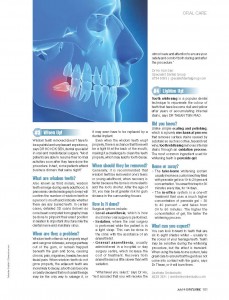 This article first appeared in the July 2014 issue of Expat Living Magazine. We have reproduced it for the information of those of you who missed it when it was published.
This article first appeared in the July 2014 issue of Expat Living Magazine. We have reproduced it for the information of those of you who missed it when it was published.
Wisdom teeth removal doesn’t have to be a painful and unpleasant experience, says Dr HO Kok Sen, dental sepcialist in oral and maxillofacial surgery. “Most patients are able to resume their normal activities soon after they have done the procedure. In fact, some patients attend business dinners that same night!”
What are wisdom teeth?
Also known as third molars, wisdom teeth emerge during early adulthood. A panoramic dental radiograph (x-ray) will confirm the number of wisdom teeth in a person’s mouth and indicate whether there are any buried teeth. In certain cases, detailed 3D scans (known as cone beam computed tomography) may be done to pinpoint their exact position in relation to important structures like the dental nerve and maxillary sinus.
When are they a problem?
Wisdom teeth often do not properly erupt and can grow sideways, emerge partway out of the gum, or remain trapped beneath the gum and bone, causing chronic pain, migraines, headaches and facial pain. When wisdom teeth do not grow properly, the adjacent teeth are more likely to decay; a tooth can become so badly decayed that root canal therapy may be the only way to salvage it, or it may even have to be replaced by a dental implant.
Even when the wisdom teeth erupt properly, there is a chance that there will be a tight fit at the back of the mouth, making it a challenge to clean the teeth properly, which may lead to tooth decay.
When should they be removed?
Generally, it is recommended that wisdom teeth are removed in one’s teens or young adulthood, when recovery is faster because the bone is more elastic and the roots shorter. After the age of 30, you may be at greater risk of gum disease in the surrounding tissues.
How is it done?
Surgical options include:
- Local anaesthesia, which is how most minor oral surgery is performed.
- Sedation, where the oral surgery is performed while the patient is in a light sleep. This can be done in the clinic with the assistance of an anaesthetist.
- General anaesthesia, usually administered in a hospital or day surgery centre, which increase the cost of treatment. Recovery from anaesthesia is a little slower than with sedation.
“Whichever you select,” says Dr Ho, “rest assured that you will receive the utmost care and attention to ensure your safety and comfort both during and after the procedure.”





